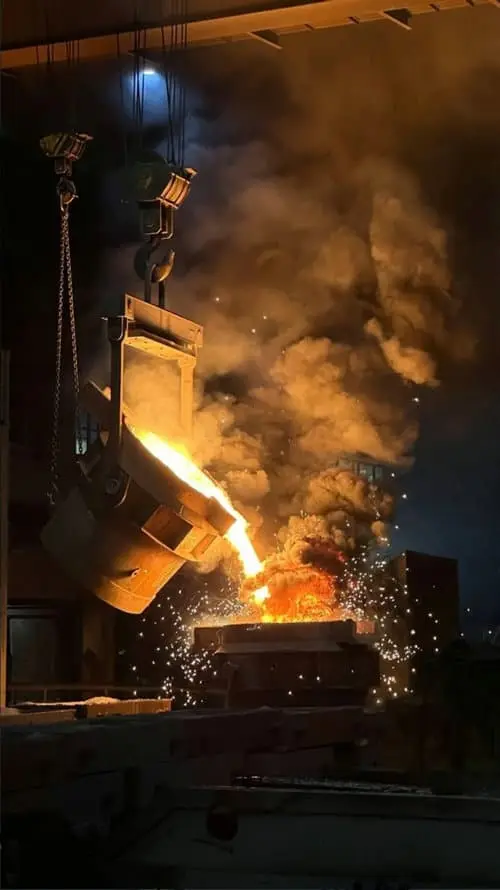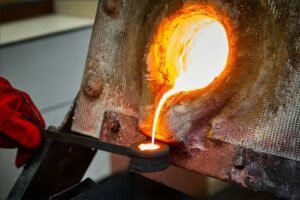Saat bekerja dengan logam dan paduan, istilah seperti “peleburan” Dan “meleleh” sering muncul, but they refer to different processes. While both involve the transformation of solid metals into liquid form, they are distinct in terms of their purpose, methods, and outcomes. Understanding these differences is crucial, especially in industries such as metallurgy, pengecoran, dan daur ulang, where precision and terminology matter.
In this article, we’ll explore the key distinctions between smelting and melting, shedding light on the processes, aplikasi mereka, and the equipment used in each.
What is Melting?
Melting is a physical process in which a solid material transitions to a liquid state when heat is applied. This happens when the temperature rises above the material’s melting point, which is the temperature at which the solid and liquid phases coexist in equilibrium.
Key Features of Melting:
- Tujuan: The primary purpose of melting is to convert a solid metal or material into a liquid form. It is often used in casting, pengelasan, or manufacturing processes to shape metals or alloys.
- Temperature: The temperature required for melting depends on the material. Contohnya, aluminum melts at about 660°C (1220°F), while steel requires temperatures exceeding 1370°C (2500°F).
- No Chemical Change: Melting is a physical change, meaning the chemical composition of the material remains the same. It simply changes from solid to liquid.
- Aplikasi: Melting is used in various industries, such as metal casting, penempaan, and even recycling, where metals are melted down to be reformed into new shapes.
Examples:
- Melting gold or silver for jewelry casting.
- Melting aluminum to create new parts or products.
What is Smelting?
Peleburan, di samping itu, is a more complex process that involves extracting a metal from its ore by applying heat and often a chemical reducing agent. Smelting not only requires the application of heat but also the introduction of other substances like flux or reducing agents to help separate the desired metal from other components of the ore.
Key Features of Smelting:
- Tujuan: The purpose of smelting is to extract a pure metal or a desired metal alloy from its ore. This involves both physical and chemical processes.
- Temperature and Chemical Reaction: Smelting requires high temperatures (typically between 1000°C and 1600°C or higher) to break the chemical bonds in the ore and release the metal. It usually involves chemical reactions where the metal ore is reduced by a substance like carbon.
- Chemical Change: Unlike melting, smelting involves a chemical change, where the ore’s components are chemically altered, separating the metal from impurities or unwanted materials.
- Aplikasi: Smelting is used in metal extraction from ores, such as copper, besi, emas, and other precious metals. It plays a critical role in the mining and refining industries.
Examples:
- Smelting iron ore with coke to produce pig iron in a blast furnace.
- Smelting copper from sulfide ores by using a process that separates sulfur and iron from the copper.
Key Differences Between Smelting and Melting
Tujuan:
- Meleleh: Converts a solid material into liquid form, often for shaping or casting purposes.
- Peleburan: Extracts a metal from its ore, often involving chemical reactions to separate the metal from impurities.
Process Type:
- Meleleh: A physical process that does not change the chemical composition of the material.
- Peleburan: A chemical process that alters the chemical composition of the material, reducing ores into pure metals.
Temperature:
- Meleleh: Requires temperatures just above the material’s melting point.
- Peleburan: Requires much higher temperatures to facilitate the chemical breakdown of the ore.
Chemical Reaction:
- Meleleh: No chemical reaction occurs; it’s simply a phase transition.
- Peleburan: Involves chemical reactions, such as reduction (removing oxygen) or the use of flux to remove impurities.
Equipment Used:
- Meleleh: Melting is typically carried out in furnaces, crucibles, or induction melting systems designed to heat materials to their melting points.
- Peleburan: Smelting requires specialized equipment like blast furnaces, smelting furnaces, or electric arc furnaces designed for high-temperature chemical reactions.
Applications of Smelting and Melting
- Meleleh is used in a variety of applications like:
- Pengecoran logam: Creating parts, mesin, or components by pouring melted metal into molds.
- Welding and mematri: Using heat to melt materials and join them together.
- Daur ulang: Metals like aluminum and steel are melted down to be reused in new products.
- Peleburan is mainly used in the mining and metal extraction industry:
- Extraction of metals from ores: Misalnya, extracting copper from copper ore or iron from iron ore.
- Refining metals: Purifying metals by removing impurities through processes like slagging or oxidation.
- Production of alloys: Smelting can be used to produce specific metal alloys by mixing metals during the process.

Kesimpulan
While meleleh Dan peleburan might sound similar, they represent two distinct processes with different purposes and outcomes. Melting is a straightforward physical process that turns solid materials into liquid form, typically used in casting, manufacturing, dan daur ulang. In contrast, smelting is a more complex process that involves the extraction of metals from ores through chemical reactions, often used in mining, refining, dan produksi paduan.
Understanding these differences is crucial for professionals in the metallurgy, manufacturing, and recycling industries to choose the right processes for their needs. Whether you’re casting a new part or refining a metal, knowing the right approach can make all the difference in the efficiency and quality of the final product.







